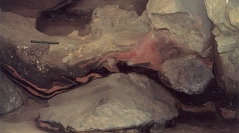

 Comptes Rendus Palevol
21 (27) - Pages 551-594
Comptes Rendus Palevol
21 (27) - Pages 551-594The study of fossil bone assemblages has brought up evidence of the existence in the Pleistocene of faunal communities with no modern analogues. This is notably the case for Palaeolithic archaeological sites that have yielded, in the same stratigraphic layers, remains of species that are rarely sympatric in present-day ecosystems. The Mousterian – layer C – and Châtelperronian – layer B – of Grotte XVI (Dordogne, France) provide examples of such “composite” faunas: high proportions of Red deer (21 % and 34 % of the total number of identifiable remains of ungulates, respectively), Roe deer (17 % and 14 %) and Reindeer (42 % and 26 %) have been described in the same assemblages. In order to better interpret these no-analog communities, large mammal remains from layers B and C of Grotte XVI are reanalysed here. Taxonomic identifications, taphonomic data (cortical surface states, anthropic marks, evidences of carnivore activity, etc.), season-of-death estimates and bone refits (intra- and inter-layers) are combined and analysed as part of a three-dimensional spatial study of the faunal assemblages.
Southwestern France, Mousterian, Châtelperronian, Cervidae, Cave bear, paleoecology, zooarchaeology, taphonomy